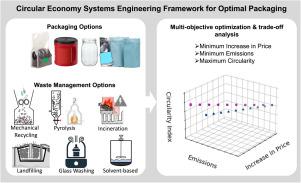综合决策方法,同时设计食品包装和废物管理技术,以实现循环经济
IF 3.9
2区 工程技术
Q2 COMPUTER SCIENCE, INTERDISCIPLINARY APPLICATIONS
引用次数: 0
摘要
食品包装在食品供应链中起着基础性作用;然而,塑料垃圾的激增,再加上有限的回收工作和不当的处理,强调了可持续食品包装解决方案的必要性。循环经济可以通过促进回收和利用可再生资源来帮助减轻与包装相关的环境影响。然而,文献缺乏综合的方法来分析食品包装和废物管理策略以及它们的经济,环境和循环影响。本研究提出了一个系统工程框架,该框架采用多目标混合整数线性优化模型,以经济和环境标准为基础,确定包装和废物管理技术的最佳组合。采用上层建筑方法,结合技术经济分析(TEA)、生命周期评估(LCA)和循环性评估,提出的框架在考虑废物管理方案的同时,为指导食品包装选择提供了见解。一个以咖啡包装为重点的案例研究说明了该框架的适用性。结果表明,最具经济效益的途径包括使用多层袋与先进的回收技术相结合,生产高质量的塑料树脂。考虑到玻璃收集和洗涤设施之间的距离较短,可重复使用的玻璃容器成为温室气体(GHG)排放最少的选择。此外,研究表明,温室气体排放量最低的路径并不一定表现出最高的循环度得分,模型确定了当运输距离较长时温室气体排放和循环度之间的权衡解决方案。在帕累托前沿,成本、温室气体排放和循环之间的权衡被探索和可视化,有助于明智的决策。本文章由计算机程序翻译,如有差异,请以英文原文为准。

Integrated decision-making approach for the simultaneous design of food packaging and waste management technologies to achieve a Circular Economy
Food packaging plays a fundamental role in food supply chains; however, the surge in plastic waste, coupled with limited recycling efforts and improper disposal, emphasizes the need for sustainable food packaging solutions. Circular Economy can help mitigate environmental impacts associated with packaging by promoting recycling and the utilization of renewable resources. However, literature lacks integrated approaches to analyze both food packaging and waste management strategies alongside their economic, environmental, and circularity impacts. This study proposes a systems engineering framework, that employs a multi-objective mixed-integer linear optimization model to identify optimal combinations of packaging and waste management technologies based on economic and environmental criteria. Using a superstructure approach, and combining techno-economic analysis (TEA), life cycle assessment (LCA), and circularity assessment, the proposed framework provides insights for guiding food packaging selection while considering waste management options. A case study focusing on coffee packaging illustrates the framework’s applicability. Results show that the most economically profitable pathway involves the use of multilayer bags paired with an advanced recycling technology that produces high-quality plastic resins. Reusable glass containers emerge as the least greenhouse gas (GHG) emitting option when considering short-distances between glass collection and washing facilities. Moreover, the study demonstrates that the pathways with the lowest GHG emissions do not necessarily exhibit the highest circularity score, with the model identifying trade-off solutions between GHG emissions and circularity when transportation distances are longer. Trade-offs between costs, GHG emissions, and circularity are explored and visualized in Pareto fronts, aiding informed decision-making.
求助全文
通过发布文献求助,成功后即可免费获取论文全文。
去求助
来源期刊

Computers & Chemical Engineering
工程技术-工程:化工
CiteScore
8.70
自引率
14.00%
发文量
374
审稿时长
70 days
期刊介绍:
Computers & Chemical Engineering is primarily a journal of record for new developments in the application of computing and systems technology to chemical engineering problems.
 求助内容:
求助内容: 应助结果提醒方式:
应助结果提醒方式:


